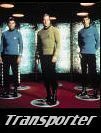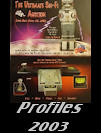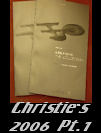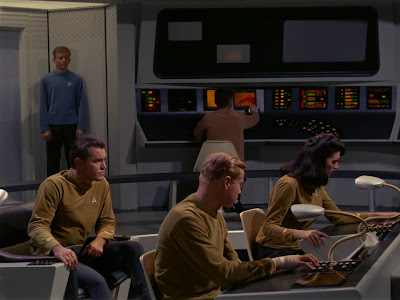The Original Series Helm and Navigation Console was most recently sold as Lot 128 in the April 26, 2003 Profiles In History Ultimate Sci-Fi Auction; held at The Westin Hotel in Los Angeles, California. It realized a price of $80,000 based on a pre-auction estimate of $80,000 - $100,000.
The Profiles auction catalog that was produced for the event contained some insightful remarks on the construction details of this outstanding set piece; as well as some exact dimensional information and what were at-the-time previously unseen photographs of its current condition. The Profiles item description is reproduced below …
COMMAND MODULE/HELM OF THE USS ENTERPRISE FROM THE ORIGINAL STAR TREK SERIES. (NBC-TV, 1966-69) The original Command Module from the bridge of the legendary starship, USS Enterprise. Constructed at the Desilu Culver studios in November of 1964 for the first pilot The Cage, this important set piece remained the focal point of the bridge throughout the entire series.
The original design for the bridge was the responsibility of Art Director Pato Guzman and then-Set Designer Walter “Matt” Jefferies (after the first pilot, Jefferies became the Art Director throughout the entire series). Although construction of the Enterprise sets was an orchestrated team effort, Special Effects Supervisor Jim Rugg and Matt Jefferies were the two primary people involved in its design and construction.
The Command Module, located directly in front of the Command Con (Captain’s Chair), is roughly T-shaped, and composed of the Helmsman and Navigator stations which are situated to the left and right, respectively, when facing the main viewing screen. It measures approx. 78 in. wide x 48 in. long. The outer cabinet is constructed of wood. The support pylon in front and the recessed supporting panels are painted grey; other vertical surfaces are painted red with black trim [in the pilot episode The Cage, all vertical surfaces were painted grey].
The Helmsman Station, manned by Hikaru Sulu (played by George Takei), is covered with a heavy-gauge aluminum plate, painted black. Its most notable attribute is the scanner, which is concealed beneath the console when not in use. When activated, an ingenious electrical powered “retractable gear”, finely crafted from heavy-gauge aluminum, opens a trap door in the panel and unfolds the targeting scanner to extend to a convenient height for the Helmsman to view. Note: The original vaccu-formed viewfinder attached above the aluminum gear is missing. The gear housing beneath the panel is constructed of heavy-gauge aluminum which contains the electric motor, relay, gears and wiring. It is currently non-functioning, but can easily be restored. Matt Jefferies himself commented that the mechanical designs for this apparatus were relatively simple, but the actual construction of the piece was a nuisance. Unfortunately, its practical use on the set was compromised due to the excessive noise it created when being extended. For most of the series, the scanner was left extended to avoid drowning out the actor’s voices. To the right of the scanner, the original control panel, approx. 9 ½ in. x 9 in., is missing, but beneath shows the original electrical lighting used to illuminate the panel. Below, a narrow row of switches approx. 6 in. wide is missing.
The Navigator Station, manned for most of the series by Pavel Chekov (played by Walter Koenig), is covered with a panel made of black-painted wood fiber. The illuminated Deviation Plotter, composed of the original amber-colored “gel”, is present on the right and the clear navigation control buttons are present below. The control panel just to the left, approx. 8 ¼ in. x 8 ¼ in., is missing; however, the six original ceramic 25-watt light sockets are present and functional. The surrounding interior cabinet is lined with metal to protect the wood from the radiated heat. The narrow row of switches below is missing. At the top center of the console, the panel containing the sensors, alert light and smaller lights on either side are missing, although wiring and original ceramic socket is present for illumination from beneath. A power cord which plugs into a standard 110-volt wall socket powers the lighting for the console.
The two stations are bisected by the Astrogator, a coordinate grid system which was the essential course-tracking component of the ship. The circular coordinate grid, measuring approx. 24 ½ in. diameter, is constructed of translucent plastic which, once illuminated, appears light blue at the outer ring and yellow at the center. Beneath the Astrogator is the ship’s log and chronometer.
Over the ensuing years, the missing pieces as mentioned have either broken off, or been removed from the Command Module. These switches and epoxy resin buttons could be replicated for restoration purposes. All of the present elements are original, with the exception of the light bulbs.
The Command Module is accompanied by two letters of authenticity: one from Art Director Matt Jefferies, who examined the console in person and verified that it is the exact piece he personally designed and helped build in late 1964, further stating that there were no others built; and another letter from George Takei, who also examined the console and verified its authenticity.
The piece was on display at the Smithsonian Institution’s Star Trek exhibit in 1992, the most popular exhibit in the museum’s history, breaking all previous attendance records. It was subsequently sold as lot no. 43 at Christie’s East on June 19, 1993 to Planet Hollywood, and has since remained a part of their corporate collection.
An amazing artifact from television and science fiction history. This Command Module, the “nerve center” of the Enterprise responsible for actually flying the ship, is seen in virtually every episode of this legendary series. Without doubt, one of the greatest television props in the world. $80,000 - $100,000
The following are some selected TOS screenshots which show the Helm and Navigation Console from different perspectives …
The original console configuration from the 1st pilot "The Cage". Note the extensive use of rectangular aircraft buttons on the control panels:
The Helm and Navigations console as it appeared in the 2nd pilot "Where No Man Has Gone Before":
An intermediate appearance of the Helm station, seen in the early 1st season episode "Balance of Terror". One of the original control panels has been replaced with a design featuring the familiar multicolor circular and triangular resin buttons, and the Targeting Scope has yet to be added:
Some different views of the overall console:
The Navigation station:
The final Helm configuration:
The Helm Targeting Scope:
An early Astrogator design seen in "The Enemy Within":
The more familiar Astrogator appearance:
The Red Alert beacon and sensors:
The ships Chronometer:






















































































































































